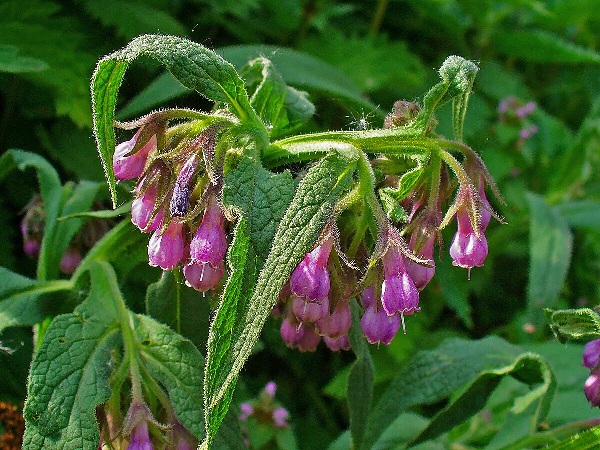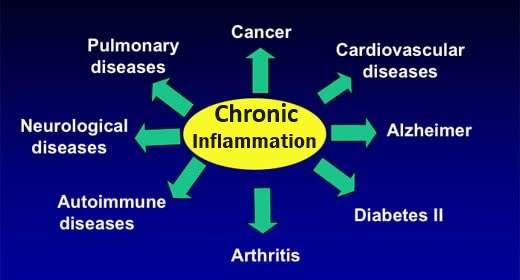Comfrey - "Knitbone or Boneset"

About
2000 year old healing plant
- Found worldwide, extracts of leaves and roots of this herbaceous planthave been used for centuries to heal wounds /skin conditions and reduce pain and inflammation. Dioscorides, a 50 A.D. physician, prescribed comfrey for healing wounds and broken bones, traditional Chinese medicine has used comfrey for 2000 years, and comfrey is listed in the Materia Medica of the MIddle Ages;
- Comfrey is used medicinally in oils, creams, salves, poultices and teas.
A member of the borage family, its botanical name Symphytum comes from the Greek word symphyo, meaning unite.
3 best known species of comfrey
- True / Wild / Common Comfrey. Symphytum Officinale – Native to England, extends to most of Europe, Central Asia and Western Siberia
- Prickly or Rough Comfrey. S. asperum Lepechin (a.k.a. S. asperrimum) – Bristly / hairy leaves; brought from Russia to Britain ~1800
- Russian, Blue or Quaker Comfrey.S. x uplandicum Nyman (a.k.a. S.peregrinum) – Natural hybrid of S. officinale L. and S. asperum Lepechin originating in Russia. Henry Doubleday, a British researcher and a quaker, promoted use of this hybrid comfrey for food and forage. He shipped cuttings to Canada in 1954. The majority of comfrey grown in the U.S. is this species.
Comfrey’s main active constituents
- Allantoin (0.6-0.8%).Roots contain higher levels than leaves
- Cell-proliferant (increases cell multiplication rate).Promotes the granulation and formation of epithelial cells (especially fibroblasts) – these line the surfaces of the body. E.g. skin, blood vessels, intestines, urinary tract, organs, esophagus. Can boost growth of skin cells and so has a vulnerary effect to heal skin problems, wounds, sores, burns;
- Leucocytosis promoter. Increases number of immune system white cells to speed healing.
- Collagen-builder. Rebuild fibrous tissue (bundles of collagen fibers interspersed with row of connective tissue cells), such as tendons, ligaments, and repair bone fractures;
- Rosmarinic acid and steroidal triterpene saponins. Anti-inflammatory / reduces pain and swelling. Useful for rheumatoid arthritis, sprains, bruises (incl. contusions);
- Mucilage (mainly in root, up to 29%).This emollient polysaccaride moisturizes andsoothes tissues, strengthening the mucopolysaccaride beween body’s cells after damage from such as sunburn or burns.
- Silicic acid and tannins (astringent – 2.4% in dried leaves), inulin (converted to fructose)
ORAL comfrey has been banned in most countries
The concern is that comfrey contains pyrrolizidine alkaloids (PAs). PAs include symphytine, echimidine, symglandine and lycopsamine. When taken orally in excessive amounts, PA’s can cause sinusoidal obstruction syndrome and severe liver injury. Oral forms include herbal teas, capsules and root powders. There is major controversy over the real risk of consuming a moderate amount of comfrey. Humans have consumed comfrey widely as a vegetable and have a long history of taking comfrey formulations of tea or tablets.

What are the health benefits of comfrey?
Comfrey is applied externally (as extracts, ointments, or compress pastes of comfrey leaves and roots) to treat:
- Joint inflammatory disorders, myalgia, gout, hematomas, thrombophlebitis, . Several randomized, controlled trials have demonstrated the efficacy of topical comfrey preparations in the treatment of muscle and joint pain, inflammation and swelling in degenerative arthritis, acute myalgia in the back, sprains, contusions and strains after sports injuries Staiger, 2012. Recently, an herbal practitioner survey of the external use of comfrey in the United Kingdom indicated that comfrey is rated most effective for fractures, wounds, healing after surgery, and problems with tendons, ligaments, and muscles, although it is less effective for treating boils, hemorrhoids, and varicose veins Frost et al., 2014. Comfrey root preparations exhibited significant antioxidant activities when compared to known antioxidants. and are used for external treatment of joint distortions and myalgia, due to the root’s analgesic and anti-inflammatory properties.
- Wounds, bone fractures, bruises, sprains. Comfrey acts as an anti-inflammatory and its allantoin stimulates cell proliferation to promote healing.
For internal applications, comfrey has been used (as infusions and extracts) to treat:
- Gastritis, stomach and duodenal ulcers, and lung congestion Symphytum Species: A Comprehensive Review… , 2019.
- Rheumatic pain, arthritis, bronchitis, and colitis.

Is it safe to use medicinal comfrey leaves or roots?
INTERNALLY consuming REGULAR / EXCESSIVE amounts of comfrey may cause liver / kidney damage
To be safe, anyone with serious liver or kidney disease or taking hepatotoxic drugs should not use comfrey internally
The U.S. FDA warns that REGULAR consumption of LARGE amounts of comfrey tea, pills, root powder and/or extracts can lead to sinusoidal obstruction syndrome (SOS) (formally called hepatic veno-occlusive disease, potentially, a fatal form of liver damage caused by drugs / toxins, which can trigger fibrosis by altering DNA), and/or similar kidney cell damage. In the U.S., comfrey-pepsin capsules are a likely source for concern;
Comfrey contains several potentially toxic UNsaturated pyrrolizidine alkaloids (uPAs) (saturated PAs are NON- toxic) which have been linked to hepatic cancers and hepatotoxicity in animal and clinical studies. . uPAs in comfrey include primarily symphytine and echimidine, but also symglandine and lycopsamine. PAs are present in the plant families: Boraginaceae (E.g. Symphytum offinale (comfrey), Borago offinales (borage)),Fabaceae and Asteraceae (e.g. summer ragwort, gravel root, boneset, butterbur and coltsfoot), as part of their defense mechanism. If the liver’s normal detoxification pathways are compromised or overwhelmed (e.g. by high dose uPAs), then uPA’s are metabolized by the cytochrome P450 enzymes into highly toxic pyrrole metabolites with alkylating properties that can damage hepatic endothelial cells and can lead to SOS. Similarly, pyrrole can damage kidney cells. Damage can accrue slowly, silently and cumulatively with low- level comfrey consumption. Pyrrole can be broken down in the liver by glutathione and glutathione S- transferase enzymes in the liver.
Liver injury is typically seen 1- 2 months after regular, EXCESSIVE comfrey consumption. Beginning with right upper quadrant pain, nausea and fluid retention / weight gain, which is followed by jaundice. Infants seem to be particularly susceptible. It is noted that as of 2015, studies have only shown association, and not causation, of comfrey PA’s with liver toxicity. An inference is made that comfrey must cause toxicity, because PA’s in other herbs, such as senacio, have shown causal liver toxicity.
What are the risk factors for uPA-associated damage?
- Family history. SOS, liver cirrhosis, pulmonary hypertension and right heart failure
- Poor liver health. History of infection, alcohol abuse
- Children 1- 14. Even after consideration of lower body weight
- Babies / fetuses. Due to higher copper levels in their livers
- Pregnant / lactating mothers. uPAs cross placental barrier, show up in milk
- Regular honey consumption. May provide chronic low- dose of uPAs if bees visited PA- containing plants;
- Concurrent use of certain herbs. E.g. Hypericum perforatum (St John’s Wort) / medications that induce CYP450 metabolic pathway
- Low glutathione levels. Possibly caused by high alcohol intake, low dietary sulfur / protein / selenium, or genetic factors
Alkaloid content of comfrey
Varies according to different studies – but generally PAs vary by:
- Species – and even byIndividual plant; more prickly species (E.g. Prickly, Russian) contain more PAs than less hairy leafed species.
- Growth state – age of plant; young leaves have higher concentration than older leaves; Small leaves of S. x Uplandicum found to have 16- fold increase over larger leaves. Mattocks AR (1980) Toxic pyrrolizidine alkaloids in comfrey Lancet 2 1136 – 7
- Plant part – roots have ~10 times more PAs than stems, flowers, leaves Roitman 1981; highest concentration in small young roots, extreme exodermis and rhizome center.
- Time of harvesting and location
PAs convert to N- oxides, which forms are also toxic and not always counted in studies – estimated to be 7 times PA count. Paul M Ridker et al, 1985. A high concentration of symphytine is present in tea as its more soluble N- oxide – these derivatives could be reduced in vivo to their native PA and subsequently metabolised to the hepatotoxic pyrrole. Analysis of herbal teas made from the leaves of comfrey
Unsaturated PAs are both water- and alcohol- soluble – and so can be found in teas and tinctures
Echimidine (likely the most toxic PA in comfrey) – in prickly and Russian comfrey, and ~25% of tested samples of Common comfrey. Jaarsma, T.A., et al., 1989.
| Symphytum Species | Leaf PAs Conc. | Leaf PA Daily intake | Root PAs Conc. | Root PA Daily intake | Notes |
| S. Officinale | 15- 55 ug/g | 3 cups tea: | 450- 8320 ug/g | Roitman 1981 | |
| S. x Uplandicum | 30- 2200 ug/g | 100- 2270 ug/g | |||
| S. Asperum | 1400 and 4000 ug/g | ||||
| Comfrey- pepsin capsules | 6 capsules:0.9 mg PAs (includes N oxides) | 6 capsules contain 9.6mg PAs (includes N oxides) | |||
| Comfrey- pepsin: typically taken 6/day | 6 Leaf capsules contain0.9mg PAs | 270 – 2900 ug PAs/g;Huxtable et al 1986; PA count includes N oxides; one capsule contains ~350mg comfrey |

Guidelines for using comfrey
External / Topical Use of comfrey
EXTERNAL use of comfrey root or leaves is NON- toxic
- However, applying comfrey to broken skin allows comfrey PAs to enter blood stream. Also, combining DMSO with comfrey for external use is equivalent to taking it internally – since DMSO allows comfrey to penetrate skin through to the bloodstream.
Using comfrey internally (i.e consuming it)
The SALE of comfrey products for INTERNAL use is illegal in the U.S. and Canada – but it is legal to purchase and grow your own comfrey in the U.S.
Based on the HMPC public statement on the use of herbal medicinal products containing toxic, unsaturated pyrrolizidine alkaloids (PAs) – The acceptable daily intake is maximum 0.007 μg/kg/day for cutaneous preparations. (Assessment report on Symphytum officinale L., radix). Generally for adults the calculation is done with a body weight of 50 kg. Therefore the daily dosage would be: 0.007 μg/kg/day x 50 kg body weight = 0.35 μg/person/day for short- time use only (maximum 2 weeks).
Given its historic use, consuming comfrey for a maximum of 4 weeks is not generally considered extreme;
Use Common rather than Russian comfrey, and leaves not roots (leaves contain less PAs). Prefer comfrey source with a lower uPA (unsaturated PA) content
DAILY dose limit of 3 – 5 ml liquid extract or 3- 5 g comfrey leaves in tea (in divided doses).~1 tsp. (1.5g) dried comfrey leaves makes 1 cup of tea.
- Comfrey tea drinkers could be ingesting up to 5 mg of PAs per day(i.e. 0.083 mg/ kg body weight /day).Ingested toxic dose for humans is ~ 0.1- 10 mg PAs/kg body weight per day.In fatal cases, total comfrey ingestion estimated 6- 167 mg/kg of body weight) and non- fatal cases of sinusoidal obstruction syndrome (SOS) at 2- 27 mg/kg.Speijers and Egmond, as cited in Deshpande 2002b [81], p. 368)
Utilize a concurrent liver / kidney pyrrole-effect detoxifier:
- Licorice extract. Alkaline Glycerite (alkaloids not water-soluble in alkaline environment) / Glycyrrhizin – Rat study found that taking glycyrrhiza for 3 days prior to injection of powerful UPA retrorsine greatly prevents pyrrole damage to liver
Lin G 1999 - Sulfur. Glutathione is a powerful “in- house” antioxidant critical to detoxifying pyrrole in the liver, and glutathione’s key-limiting ingredient is sulfur, particularly found in N acetylcysteine (500- 2000mg daily on empty stomach), alpha lipoic acid (300- 600mg 1- 3 x daily, also lowers blood sugar), MSM (1- 5g daily), glucosamine sulfate (1500 mg /day divided doses). Good food sources of sulfur include egg yolks, cabbage, broccoli, cauliflower, Brussels sprouts, kale, collards, asparagus, onions, and garlic.
- Possibly taurine and heparin
References
Jaarsma, T.A., et al., Chemotaxonomy of the Symphytum officinale agg. (Boraginaceae). Plant Systematics and Evolution, 1989. 167(3- 4): p. 113- 128. Ref













